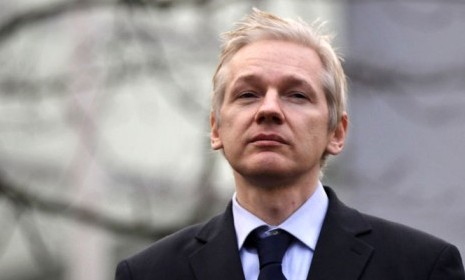How the NYT dealt with Julian Assange: 6 key takeaways
The New York Times' editor, Bill Keller, relates how his team negotiated — and eventually fell out — with the mercurial founder of WikiLeaks

Bill Keller, the editor of The New York Times, has published a detailed account of his newspaper's dealings with WikiLeaks in the past six months. In it, Keller describes his and his reporters' relationship with the website's "elusive, manipulative and volatile" founder, Julian Assange, and how the newspaper's various exclusives came together. Here, the key takeaways from Keller's piece:
1. Assange: From Peter Pan to Stieg Larsson character
At first, says Keller, Assange seemed a little like the boy who never grew up. Once, when walking with a group of Times and Guardian journalists, Assange "suddenly started skipping ahead of the group... he had a bit of Peter Pan in him." But despite Assange's childlike demeanor, Times reporter Eric Schmitt recalls that he dressed in rotting sneakers and crumpled clothes like a bag lady: "He smelled as if he hadn't bathed in days." But he was "transformed by his outlaw celebrity." Out went the stinking clothes, and in came "fashionably skinny suits and ties." At this point, writes Keller, Assange seemed like a "man who could figure either as a hero or a villain" in the "megaselling Swedish novels" of Stieg Larsson.
The Week
Escape your echo chamber. Get the facts behind the news, plus analysis from multiple perspectives.

Sign up for The Week's Free Newsletters
From our morning news briefing to a weekly Good News Newsletter, get the best of The Week delivered directly to your inbox.
From our morning news briefing to a weekly Good News Newsletter, get the best of The Week delivered directly to your inbox.
2. The NYT's "amateurish" spy code
Seduced by the "air of intrigue" surrounding WikiLeaks, says Keller, not to mention a "source who acted like a fugitive," the Times staff adopted a spy-like approach during their initial research into Assange's war logs. Reporters exchanged notes on Skype, thinking their phones might be tapped. On conference calls, Keller and his team "spoke in amateurish code," referring to Assange simply as "the source" and the data as "the package." Keller admits to being just as concerned about the "cyberwiles of WikiLeaks itself" as he was about the NSA or Pakistani intelligence.
3. The Guardian's leftist spin
Keller describes the "good working relationship" between the Times and The Guardian, who worked together on the leaked documents, but can't resist a dig at his British rival's partisan politics. The "openly left-leaning newspaper," writes Keller, claimed the Afghanistan log revealed "hundreds" of suppressed civilian casualties. But the Times found that the previously unreported deaths "did not add up to anywhere near 'hundreds.'" The Guardian's overall tally, he concludes, was "little better than a guess."
A free daily email with the biggest news stories of the day – and the best features from TheWeek.com
4. How Assange fell out with the Times
The Times' relationship with Assange went from "wary to hostile" over the publication of the Iraq and Afghanistan war logs, writes Keller. It broke down completely in October, when the Times published a front page profile of Assange, documenting the rivalries and fallings-out within the WikiLeaks team. As a result, Assange denied the Times access to WikiLeaks' trove of diplomatic cables. He would only relent if the newspaper published a front-page apology for its October profile. Keller refused, and in the end, The Guardian shared its material with the American newspaper without Assange's permission.
5. What wasn't in the diplomatic cables
The Times searched in vain for several earth-shattering bombshells in the trove of diplomatic cables, says Keller. A search for reports on Pat Tillmann, the former football star killed by friendly fire in Afghanistan, produced nothing. Nor were there any hints about "how Osama bin Laden eluded American forces in the mountains of Tora Bora." If these cables exist, says Keller, "they were presumably classified top secret or higher"
6. The WikiLeaks Christmas card
In December, as Assange descended deeper into paranoia and anger at his media partners, his lawyers showed they had a sense of humor, says Keller. Even as the WikiLeaks founder was awaiting news about his Swedish rape charges and possible extradition to the U.S, one of his legal team sent out a "mock Christmas card" from the organization. "The message," relates Keller, was this: "Dear kids, Santa is Mum & Dad. Love, WikiLeaks."


